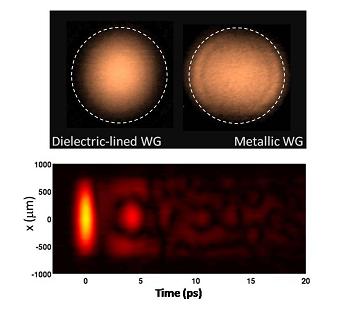|
|
|
|
Terahertz Near-Field Microscopy Research |
Ultrafast Laser Laboratory Department of Electronic and Electrical Engineering |
|
The Ultrafast Laser Laboratory is focused on development and applications of Terahertz near-field microscopy, which allows detection and visualisation of electromagnetic fields of THz frequencies on the micron scale. This capability can help advancing development of THz technologies. Combined with THz spectroscopic analysis this technique also provides a unique opportunity to investigate fundamental physical processes in condensed matter systems. |
Recent research highlights |
||
|
THz microscopy applications: observation of THz surface waves in graphene
|
THz near-field microscopy for device research |
||
|
Visualisation of THz fields on the sub-wavelength scale can uncover the underpinning physics for THz device research. This technique allows measurements of device characteristics that are difficult or impossible to assess with far-field methods. |
Analysis of Modes in THz Waveguides |
||
|
Identification of propagating modes is essential for characterization of the waveguide transmission properties. It helps to optimize the waveguide design and reduce losses, which present a major challenge for THz waveguide research. Time-resolved THz near-field microscopy helped to determine and investigate propagating modes in hollow metallic waveguides. The dominant mode in a hollow metallic waveguide has the electric field terminating abruptly at the waveguide wall, while the dominant mode in a similar waveguide with a thin dielectric coating, has the electric field vanishing near the wall. As a result, Ohmic transmission losses are reduced substantially in the dielectric-lined waveguides (Appl. Phys. Lett. 93, 181104 (2008), PDF). The near-field images of the waveguide output clearly show the difference in the mode structure (left and right panels). A space-time map (bottom panel) measured with the near-field probe also allows to determine whether higher order modes are present. These modes propagate with lower group velocities and have distinctive electric field spatial patterns.
Applied Physics Letters 94, 171104 (2009) PDF |

|
THz Near-Field Microscopy Animation |
||
|
Visualisation of a plane-wave coupling to a dipole antenna commonly used in photoconductive (Auston) switches. The animation shows how the incident THz wave excites current oscillations in the dipole region of the antenna. Slowed down by 1012 times, the animation spans 1 ps and corresponds to approximately one full oscillation of the THz field. (The animation is repeated 5 times).
In the experiment, a short pulse of THz radiation is incident on the antenna structure in the direction
normal to the substrate surface. The electric field
maps are measured by scanning a sub-wavelength aperture probe over the surface of the antenna.
The animation shows that a portion of the electro-magnetic energy couples to the transmission lines
and propagates along the surface (right and left) away from the dipole. |
|
University College London - Gower Street - London - WC1E 6BT - ![]() +44 (0)20 7679 2000 - Copyright © 1999-2013 UCL
+44 (0)20 7679 2000 - Copyright © 1999-2013 UCL